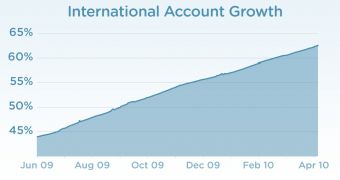Twitter is slowly but surely turning into an international phenomenon after having become wildly popular in its native US about a year ago. Since then, growth in the US has slowed down to a trickle, but outside its borders people are signing up for the 'information network' in growing numbers. According to data released by Twitter itself, more than 60 percent of its users now come from outside of the US and their numbers are still rising. Partly responsible for this is Twitter's increasing internationalization effort, but also the stagnating growth in the US.
"Twitter's first users were the early employees and their friends, largely based around our offices in San Francisco. Today we are a global information network, with a robust developer ecosystem and a website available in six languages. Our users on Twitter are even more geographically diverse — we're proud to report that over 60% of registered Twitter accounts come from outside the US," Matt Sanford, lead engineer of Twitter's International team, wrote.
The percentage number is new, but the fact that Twitter was growing internationally much faster than it did on its home turf has been known for several months now. Still, it shows that the service has plenty of space to grow even if some are worried that it may have reached its peak in terms of user numbers. For comparison, Facebook has an even bigger percentage of international users, over 70 percent of its 450 million users. Twitter doesn't disclose how many registered or active users it has.
Twitter says the site started seeing a bigger adoption in the regions for which a localized version had been made available. For example, a Spanish version of Twitter was launched in November 2009, the first language in the site's new internationalization wave. Since then, Twitter saw a 50-percent increase in new users in Spanish-speaking regions. The tragic Chilean earthquake spurred a 1,200-percent growth in registrations. In other countries, like India and Columbia, politicians, celebrities and other public figures who started using the service spurred a big interest from the general public.

 14 DAY TRIAL //
14 DAY TRIAL //